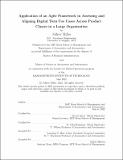Application of an Agile Framework in Assessing and Aligning Digital Twin Use Cases Across Product Classes in a Large Organization
Author(s)
Miller, Jeffrey
DownloadThesis PDF (374.6Kb)
Advisor
Hansman, R. John
Spear, Steven
Terms of use
Metadata
Show full item recordAbstract
In order to fully realize the benefits of the Fourth Industrial Revolution, companies must migrate legacy software and processes to state-of-the-art systems that fully incorporate technologies enabled by the Internet of Things, namely Digital Twin and Digital Thread. Digital Twin technologies hold the promise of significant advantages in design and manufacturing, particularly for complex products with a long lifecycle. In an early effort to adopt these technologies, large organizations are investing resources in defining and iterating upon their nascent Digital Twin capabilities. However, particularly in a large organization, use cases for Digital Twin technologies can differ according to product class. This thesis presents as a case study one such migration process in a large aerospace manufacturing organization. The research defined and applied an Agile framework to a team’s current processes to assist them in better understanding the Digital Twin use cases present across the full enterprise, and to align their efforts accordingly. In applying the Agile framework to improve team alignment and gather additional feedback, a measurable change in Digital Twin representation specifically within the context of configuration definition and change management was effected, making Digital Twin configuration representations and change management tools more broadly applicable across product classes.
Date issued
2022-05Department
Massachusetts Institute of Technology. Department of Aeronautics and Astronautics; Sloan School of ManagementPublisher
Massachusetts Institute of Technology